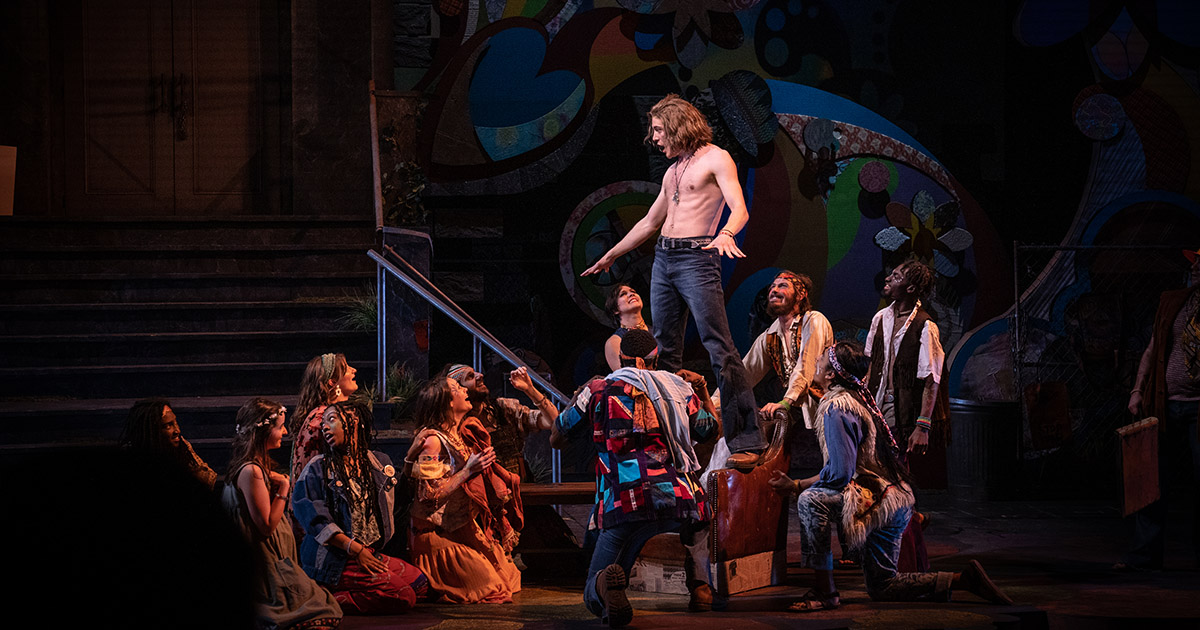Hair, the rock musical that opened off-Broadway in 1967 and had a substantial Broadway run of four years, practically defined a generational era in American cultural history, not just with its statements of love, peace, and personal freedom, but also with its colorful reflection of 60s visual style. In addition to its much-discussed use of nudity, Hair also became known for delving into anti-war sentiment, homosexuality, marijuana and psychedelic drug use, and profanity, none of which has any real shock value today. Over the years, though, the musical has still retained a substantial nostalgic following—probably for its engaging pop-rock music—a popularity that resulted in a 2009 Broadway revival earning a Tony Award. As Clarence Brown Theatre opened its own production of Hair last week, the question being bandied about was: “Can Hair still entertain, shock, or affect us in the way it might have done in 1968? Or is it merely an amusing and quaint cultural relic now relegated to our theatrical rear-view mirror?”
Of course, one of the joys of a resident university theatre program is that it can devote creative energy and an educational component to works that once occupied an important moment in time, but that today are unlikely to enjoy a big commercial revival. That’s certainly what CBT and director Casey Sams have done here: latching onto the iconic style and essence of the turbulent 1960s period as a support on which to hang the mostly plotless “concept” drama and exuberant music of Hair.
That delicious “non-plot,” written by Gerome Ragni and James Rado, with music by Galt MacDermot, features two young men: Claude, on the verge of being drafted into the Vietnam War, and Berger, the quintessential free-spirit. Along with two women—Sheila, a student activist, and Dionne, a flower child—are a collection of kindred spirits of the 60s—in other words, a tribe of hippies living in New York City’s East Village. Admittedly, though, the fun and success of Hair rests with MacDermot’s music which includes the iconic songs “Aquarius,” “Good Morning Starshine,” “Hair,” “Sodomy,” “Donna,” and “The Flesh Failures (Let the Sunshine In)” among a host of others. Music director Terry D. Alford once again brought the multi-textural score to life with an 11-member offstage ensemble.
In the role of Claude was CBT alum Owen Squire Smith with Robert Parker Jenkins in the role of Berger. The multi-faceted Christine Sage appeared as the activist, Sheila. On the Friday opening night, Covid apparently caused a minor upheaval in the cast. Abigail Schlichtmann took the role of Dionne, Bo Choate took the role of tribe member Woof, and Livi Fenech took the role of tribe member Hubert.

The production came alive with bright, eye-popping colors and projection effects saturating DJ Pike’s physical set of useful steps and almost obligatory urban scaffolding. Pike’s environment was lit by Kaylin Gess. Costume designer M.J. Hromek brought a snappy theatrical license to imparting a 60s essence to the actor’s wardrobe. Joe Payne’s audio scheme featured large-scale miking for the offstage orchestra as well as for the singing actors.
When Hair premiered on Broadway, writers used words like “fresh,” “unassuming,” and “likable.” That last one still applies to the show—and I’ll throw in “charming” and “exuberant.” Not bad for a 55-year old musical about happiness, hippies, and their Age of Aquarius.








